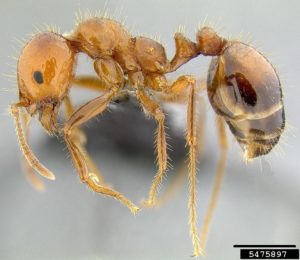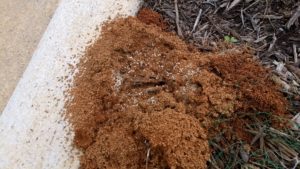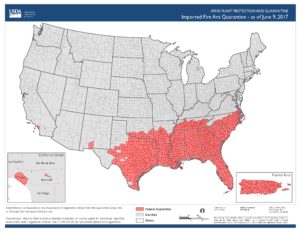Fire Ant Q&A
go.ncsu.edu/readext?697635
en Español / em Português
El inglés es el idioma de control de esta página. En la medida en que haya algún conflicto entre la traducción al inglés y la traducción, el inglés prevalece.
Al hacer clic en el enlace de traducción se activa un servicio de traducción gratuito para convertir la página al español. Al igual que con cualquier traducción por Internet, la conversión no es sensible al contexto y puede que no traduzca el texto en su significado original. NC State Extension no garantiza la exactitud del texto traducido. Por favor, tenga en cuenta que algunas aplicaciones y/o servicios pueden no funcionar como se espera cuando se traducen.
Português
Inglês é o idioma de controle desta página. Na medida que haja algum conflito entre o texto original em Inglês e a tradução, o Inglês prevalece.
Ao clicar no link de tradução, um serviço gratuito de tradução será ativado para converter a página para o Português. Como em qualquer tradução pela internet, a conversão não é sensivel ao contexto e pode não ocorrer a tradução para o significado orginal. O serviço de Extensão da Carolina do Norte (NC State Extension) não garante a exatidão do texto traduzido. Por favor, observe que algumas funções ou serviços podem não funcionar como esperado após a tradução.
English
English is the controlling language of this page. To the extent there is any conflict between the English text and the translation, English controls.
Clicking on the translation link activates a free translation service to convert the page to Spanish. As with any Internet translation, the conversion is not context-sensitive and may not translate the text to its original meaning. NC State Extension does not guarantee the accuracy of the translated text. Please note that some applications and/or services may not function as expected when translated.
Collapse ▲This week I’ve been asked several questions about fire ants. I thought I would share information about these pesky invasive insects.
Fire ants, or more specifically, red imported fire ants (Solenopsis invicta), are native to South America. These ants were first found in North Carolina in 1957. Their foothold started in Brunswick County (Wilmington, NC). They have since spread to 75 of the 100 counties in North Carolina.
How does one identify fire ants?
Adult red imported fire ants are reddish to dark brown and occur in five forms: (1) minor workers, about 1⁄8 inch long; (2) major workers, about 1⁄4 inch long; (3) winged males and (4) males, each about 1⁄3 inch long; and (5) queens, about 1⁄3 inch long. Fire ant mounds vary in size but are usually in direct proportion to the size of the colony. For example, a mound that is 2 feet in diameter and 18 inches high may contain about 100,000 workers, several hundred winged adults, and one queen (or sometimes multiple queens).

A red imported fire ant major worker (credit Eli Sarnat, PIAkey: Invasive Ants of the Pacific Islands, USDA APHIS PPQ, Bugwood.org).
If you break open an active fire ant mound, you typically find the “brood” – whitish, rice grain-like larvae and pupae. These immature ants will eventually develop into workers or winged adults. Mounds are typically constructed in open sunny areas. Those mounds constructed in clay soils are usually symmetrical and dome-shaped, while mounds built in sandy soils are often irregularly shaped. The red imported fire ant can be difficult to distinguish from native ant species. However, these are the only ants that will cause a small blister to form on your skin once bitten. And foraging fire ants do not enter the colony through the mound, they enter via tunnels that extend beyond the mound.

When the top of a fire ant mound is disturbed, the brood is visible. The brood are the whitish, rice grain-like larvae. When the mound is disturbed, the colony becomes very aggressive (credit – Seth Nagy).
How do fire ant colonies spread?
Imported fire ants spread naturally during their mating flights. This spread is usually one mile or less, but flights of up to 12 miles have been recorded. The flights occur most commonly in the spring or early summer, one or two days after a rain when the weather is warm and sunny and the wind is light.
Fire ants are also great hitchhikers. They can catch a ride on sod, nursery stock, earth moving equipment, hay, pine straw, and potted plants.
The North Carolina Department of Agriculture & Consumer Services regulates the shipment of nursery and sod farm items, as well as baled hay and straw, to areas outside of the quarantine zone. Caldwell County is not in the quarantine zone, but Catawba County is.

North Carolina map of the red imported fire ant quarantine zone and the proposed quarantine for next year (Source: N.C. Department of Agriculture and Consumer Services)
Why do fire ants appear to sting all at the same time?
Fire ants are sensitive to vibration or movement and tend to sting when the object they are on moves. For example, when fire ants swarm up a person’s leg, the person jerks or moves. Usually, whatever causes one ant to bite and sting triggers the other ants to sting to the same response. Although fire ants emit communication chemicals called pheromones, to elicit specific behaviors (alarm reaction, trail formation, queen recognition pheromones that have been documented), there is no known pheromone stimulating ants to bite and sting.
What should I do if I get stung by fire ants?
There isn’t much you can do, except watch the affected area for excessive swelling, itching, or redness, or other symptoms like shortness of breath, thickening of the tongue, sweating, etc. that could indicate a severe systemic allergic reaction. If this occurs, seek medical attention. Otherwise, treat stings as you would stings of other insects and keep them clean and intact to avoid secondary infections.
How are fire ants controlled in the landscape?
There are two basic approaches to chemical control of fire ants: a mound treatment versus a bait treatment. The goal of either treatment is to control the queen.
Individual mound treatments are often more environmentally and ecologically acceptable because they use less insecticide and limit the amount of area treated as compared to broadcast treatments. Mound treatments are also quicker than bait treatments.
Bait treatments are effective when foraging workers bring the poison bait back to the colony. However, the treatment is slower because the poison has to work its way through the colony before it will be consumed by the queen. The queen does not consume sustenance directly; it has to be passed among the colony before she consumes food.
There are some good strategies for managing fire ants that include using both mound treatment and baits. This is referred to as the two-step method. Hopefully, it will take several years before fire ants become endemic in Caldwell County and we are included in the fire ant quarantine zone. Until then, be vigilant about transporting fire ants into Caldwell County, and control them if you find them.




